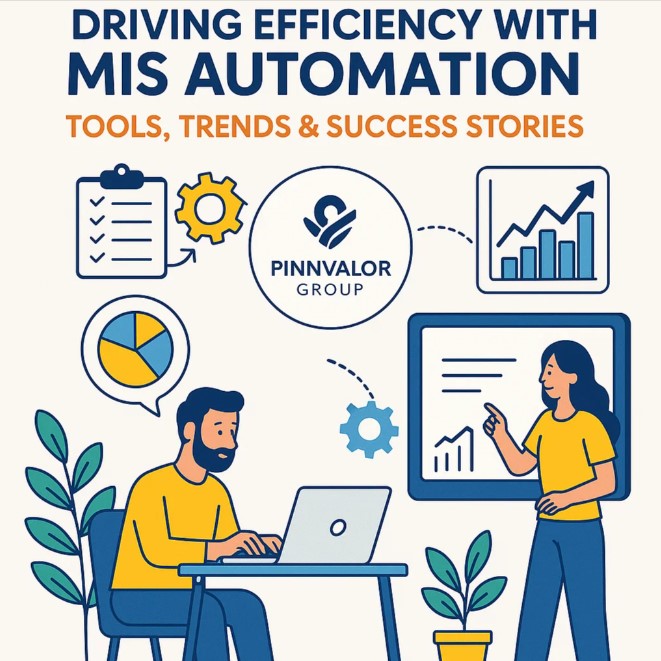
Driving Efficiency with MIS Automation: Tools, Trends & Success Stories
In today’s fast-paced business environment, organizations are generating enormous volumes of data daily. Managing, analyzing, and transforming this data into actionable insights can be challenging without the right systems in place. Management Information Systems (MIS) automation has emerged as a game-changer, enabling businesses to streamline processes, improve decision-making, and drive operational efficiency.
Could MIS automation be the key to faster, smarter business reporting?
Harness the power of AI, cloud, and real-time dashboards to make your MIS smarter. Turn data into actionable insights effortlessly.
What is MIS Automation?
MIS automation refers to the process of using technology and software solutions to automatically collect, process, and present business data for management reporting. Instead of relying on manual data entry and repetitive reporting tasks, automation ensures accuracy, timeliness, and consistency in the information presented to decision-makers.
Key Benefits of MIS Automation
- Time Efficiency: Automation eliminates manual reporting, freeing up valuable time for strategic tasks.
- Data Accuracy: Reduces human errors and ensures reliable data for decision-making.
- Real-Time Insights: Enables instant access to critical business metrics.
- Scalability: Supports growing data volumes without extra manpower.
- Enhanced Decision-Making: Provides executives with actionable insights through dashboards and analytics.
Popular Tools for MIS Automation
Organizations today have access to several robust tools to automate their MIS functions. Some of the most widely used include:
- Microsoft Power BI: Converts raw data into interactive dashboards and visual reports.
- Tableau: Advanced analytics platform for visualization, data blending, and predictive insights.
- Zoho Analytics: Cloud-based reporting tool for creating automated reports and business dashboards.
- ERP Systems (SAP, Oracle): Integrated modules that automate reporting across finance, operations, and sales.
- Google Data Studio: Free tool for automating reporting with real-time dashboards and customizable visuals.

Emerging Trends in MIS Automation
The MIS landscape is rapidly evolving. Businesses are adopting advanced technologies to make reporting smarter and more predictive:
- Artificial Intelligence (AI) & Machine Learning: Automates predictive analytics and identifies patterns in data.
- Self-Service Reporting: Empowers employees to generate reports without IT support.
- Cloud-Based MIS: Allows remote access, scalability, and real-time collaboration across teams.
- Integration with IoT & Big Data: Brings external data streams into reporting systems for better insights.
- Mobile MIS Dashboards: Provides executives access to KPIs anytime, anywhere.
Success Stories: How Organizations Benefited from MIS Automation
Several companies have successfully leveraged MIS automation to enhance efficiency and strategic decision-making:
- Retail Chain Example: A leading retail chain automated sales reporting using Power BI. This reduced report generation time from 3 days to a few hours and improved inventory management decisions.
- Manufacturing Firm: By integrating ERP with automated dashboards, a manufacturing company cut operational costs by 15% through better resource allocation and real-time production insights.
- Financial Services: A banking institution implemented AI-driven MIS automation, allowing risk and compliance teams to detect anomalies faster, improving regulatory adherence.
Best Practices for Implementing MIS Automation
- Define Objectives: Clearly outline what metrics and insights are needed.
- Choose the Right Tools: Select tools that fit the company’s size, industry, and reporting requirements.
- Ensure Data Quality: Automated reports are only as good as the data inputted.
- Train Employees: Make sure staff understand how to use dashboards and interpret data correctly.
- Iterative Improvement: Continuously refine MIS automation to adapt to evolving business needs.
Conclusion
MIS automation is no longer a luxury—it’s a necessity for organizations aiming to stay competitive. By leveraging the right tools, staying updated with emerging trends, and learning from real-world success stories, businesses can transform their reporting processes, empower decision-makers, and ultimately drive efficiency across all levels of the organization.
Embrace MIS automation today to turn your data into a strategic asset for tomorrow.
